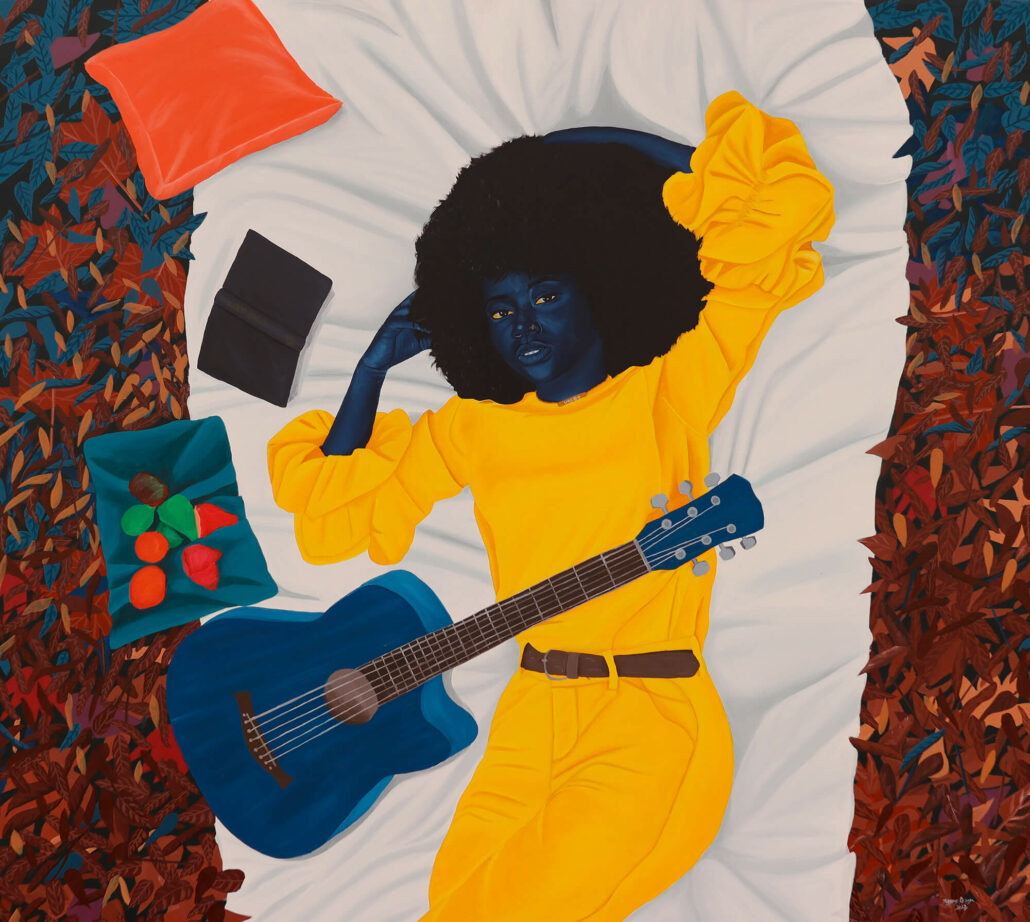The African Artists’ Foundation present Johnson Ocheja’s first solo exhibition, curated by Princess Ayoola.

Johnson Ocheja, Serenity, 2023. Courtesy of the artist and the African Artists’ Foundation.
The pilgrim is typically associated with religious iconography but the pilgrim is really anyone who seeks a deeper sense of purpose and significance in life. This questing is ultimately the journey of the artist. The artist is first crushed by society and misunderstood before seeking a safe, often solitary space that may be seen as a pilgrim’s journey.
With ‘A Pilgrim’s Journey; Through the Shades of Yellow’, Johnson Ocheja is no longer trying to be an artist, he is actualising his journey. Yellow is Ocheja’s safe colour. The colour with fewer tones than green but one that only represents happiness and joy. The purpose isn’t merely about self but also Ocheja’s documentation and relative immortalisation of his subjects.
Contemporary visual culture sells happiness through advertising as consumption but we know, research also proves that consumption and happiness are not necessarily correlated. Happiness comes from the pilgrim’s journey. Each human must work out their own salvation by themselves and all society can do is be supportive, generous and encouraging. Ocheja charges his audience to pay attention, to listen and to be kind like a child. His portraits do not titillate, they mesmerise and saturate his canvas.
In Ocheja’s work, the use of yellow holds significant symbolism, representing felicity, possibilities, and hope. Each painting’s shade of yellow resonates with the artist’s journey. There is a variability in tone and therefore in language – sometimes it exudes a lighter and spirited hue or a deeper and muddy tone. And although the human body is the primary element in these pieces, Ocheja emphasises that it is equally vital to contemplate the attire that adorns the subject – and it is these yellows, characterising his subjects’ internal worlds, that he elevates beyond aesthetic choice, to become a symbolic portal into the experience of happiness.
Foliage in these portraits serves as a recurring motif of vitality and connectedness to life sources, nature and abundance. It is a reference to our greatest desire for space, space to be, to roam, to wonder and wander. The presence of religious symbolism is an attempt to revive spiritual connections in a society that often overlooks spirituality in favour of materiality. Furthermore, in this exhibition, Ocheja uses the pilgrim archetype to reference pilgrims of old – Hindus, Buddhists and Christians alike – for whom the colour yellow symbolises knowledge, enlightenment and spiritual growth. Thus, he elevates happiness to sacred contemplation.
In truth, Ocheja’s characters are not so much striving for happiness as they are already in their gardens of pure bliss, enjoying the fruits of their journey irrespective of the simplicity of their physical reality. In ‘A Pilgrim’s Journey; Through The Shades of Yellow’, moments of domestic life are captured in Ocheja’s paintings as visual journal entries, reminding us that like a pilgrim, we must retain a journey-oriented mindset by shifting away from the romanticisation of the destination, to focus on the people and social relationships that make the destination tangible and rewarding. Again, we are reminded that happiness is not just an individual pursuit but a shared experience that brings people together and uplifts those who are struggling. It is a journey of noble curiosity.
The exhibition will be on view from the 22nd of April until the 20th of May, 2023. For more information, please visit African Artists’ Foundation.



